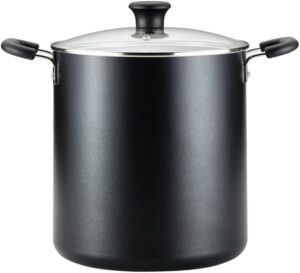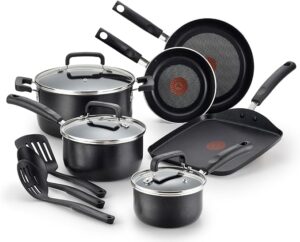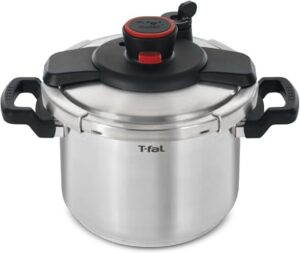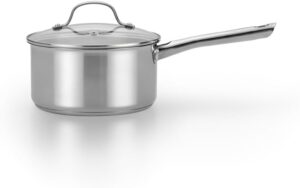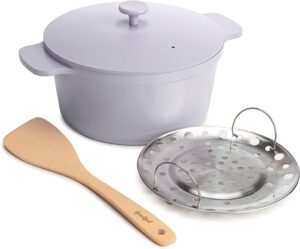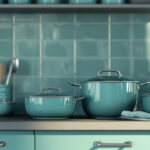What Are the Best Ways to Care for Ceramic Cookware?
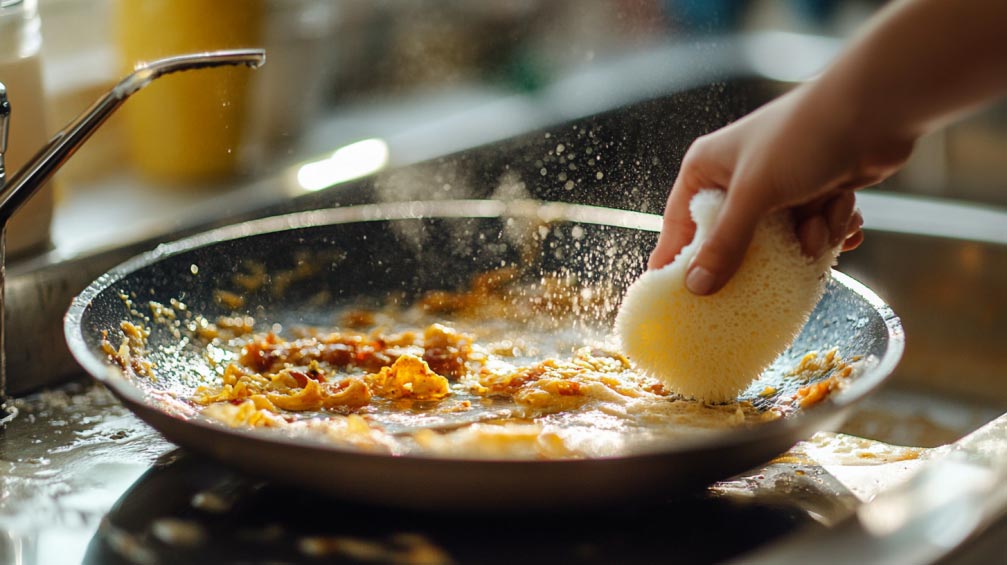
Introduction
Ceramic cookware is treasured due to their non-stick features and even heat transfers, hence quite popular in many kitchens. For that, it needs proper care to sustain its life. Only wooden, silicone, or plastic utensils are allowed because they never scratch the ceramic surface. One should completely avoid metallic utensils because they might scrape off the coating. On heat, always use the low to medium settings so as not to overheat the ceramic, causing it to crack or chip. Furthermore, it is always advisable to let cookware cool off before washing. This is so as to prevent a situation of thermal shock, which can result in cracks also.
While ceramic cookware may be comparatively easy to clean, it still does require some amount of care. Hand wash in warm soapy water with a soft sponge or cloth as an abrasive pad might scratch the surface. Then soak it in warm water and rub off gently with food residue that has stuck. Never use harsh chemical cleaners since they will really wear down the non-stick coating. Check periodically for any signs of wear, and replace the cookware if the coating deteriorates to assure your safety and effectiveness when cooking. If these ways are followed, ceramic cookware can turn out to be in good condition for many years.
Why Proper Care is Important
Proper care will definitely keep ceramic cookware in good condition and ensure its longevity. Ceramic cookware has become very popular due to its non-stick properties, even heating, and aesthetic appeal—everything that can be lost within a very short period if it is not well taken care of. Just a few easy practices will keep your ceramic cookware well cared for and functioning at the best level for years to come.
In addition, proper care should be taken in preserving the non-stick coating. This makes one cook with a minimum quantity of oil and eases cleaning up afterward. But utensils made from metal and cleaning tools that are abrasive can scratch or even totally damage this smooth surface. This will prevent this from happening: the cookware should only be stirred or turned with wooden, silicone, or plastic utensils; and this cookware is cleaned with a soft sponge or cloth. This way, its non-stick properties will remain intact, and in turn, lessen the hassle of cooking and cleaning.
This simply means controlling the amount of heat used when cooking using ceramic cookware. Ceramic is, by nature, an excellent conductor; hence, it disburses the heat around the cooking surface somewhat. Nevertheless, high heat may cause the ceramic to either crack or chip off. One should apply low to medium heat and avoid overheating. Let the cookware cool before cleaning it. This will prevent thermal shock, which can cause cracks to form and thus reduce cookware durability.
Cookware made of ceramic requires occasional cleaning and frequent checking to be in perfect condition. In most instances, hand washing with warm soapy water does it, while soaking would help substantially remove food residue. Careful avoidance of harsh chemical cleaners is important since their interaction with the cookware material results in chipping off of the ceramic coating. This way, through regular checks for any signs of wear and tear, one can effectively resolve any problem immediately to maintain performance and safety in using the cookware.
Proper care assists in prolonging the life of ceramic cookware and provides simultaneous equal cooking. Well-cared cookware has evenly spread heat, thereby eliminating hot spots mostly responsible for burning food. Even distribution is what leads to good cooking results, enabling one to enjoy meals and then prepare them more efficiently. Moreover, looking after ceramic cookware helps retain its appearance, thereby staying new and beautiful in a kitchen.
Caring and maintaining ceramic cookware to ensure longevity and performance is not Optional. If users can apply some simple care practices—adequate utensils, controlled cooking temperatures, and proper cleaning with regular inspections—a good set of ceramic cookware can turn into a long-term investment that will become a very reliable tool in your kitchen. Proper care will extend the life of the non-stick and avoid any sort of damage. This will retain consistency in results while cooking and prove to be worth the investment for any home cook.
Initial Preparation: Seasoning Your Ceramic Cookware
Seasoning the ceramic cookware before its first use is a basic step for proper performance and durability. This initial preparation creates a protective layer on the cooking surface, therefore making it more non-stick and thus greatly helping in future cooking and cleaning. Even though most of the time, ceramic cookware comes ready to use, seasoning might be required for more benefits and can really extend its lifetime.
First, clean the ceramic cookware using warm soapy water to clean off manufacturing residue and dust that the cookware accumulated during its packaging and shipment. Then, rinse well and dry it properly with a clean towel. No moisture is to be left behind on the surface.
Then, apply a thin layer of cooking oil on the entire cooking surface. Vegetable oil, canola oil, or any neutral oil with a high smoke point works good here. Use a soft cloth or paper towel to spread the oil evenly and ensure that the whole surface is well-coated. This layer of oil is important in filling up the microscopic pores on the ceramic surface, thus making it smoother and more non-stick.
Over low to medium stovetop heat, let the cookware coated with oil heat for about 5 to 10 minutes. This will allow the oil to bind to the ceramic surface and form a hard layer that enhances its non-stick properties. Be careful not to put the temperature too high, because it will just burn off the oil and create sticky residue. After heating, let the cookware cool down in its own pace. Then with a clean, lint-free cloth, wipe off the excess oil gently.
This cookware is ready to use immediately after seasoning. However, it is highly recommended that you re-season it every once in a while, especially when you feel that the food has slightly stuck to it or when the cookware has been scrubbed or cleaned thoroughly. This will help you in using the cookware for a longer period with optimal non-stick performance.
That means seasoning your ceramic cookware before its first use is one easy way to enhance its performance and prolong its lifetime. You do it by cleaning the cookware, coating a thin layer of oil into it, heating the cookware, and finally, wiping off the extra oil to form a protective layer for both cooking and cleaning purposes. Do this once in a while to keep the ‘non-stick’ feature of your cookware.
Daily Use and Maintenance Tips
Most home cooks go in for ceramic cookware due to the fact that it is non-stick and evenly distributes heat, aside from its aesthetic appeal. With these daily use and maintenance tips, you will be able to keep your ceramic cookware performing at its best and ensure a long life. Proper care keeps it looking and functioning good for a long time, so it can remain a good friend in your kitchen for years.
Dos and Don’ts of Using Ceramic Cookware
There are some dos and don’ts associated with its usage to prevent it from damage and to enable it to perform optimally. Do use wooden, silicone, or plastic utensils since these materials are light on the ceramic surface and help avoid scratches that ruin the non-stick coating. Don’t use metal utensils since they scratch and damage the ceramic surface, losing their non-stick properties in the process.
Other important factors to consider include temperature. Cooking on low to medium heat is allowed. High temperatures are not necessary because ceramic cookware spreads its temperature evenly. Actually, high temperatures will create cracks on the ceramic. Also, avoid preheating cookware on high heat since this will create thermal shock when you add cold ingredients into a hot pan. Let cookware cool by itself after cooking. Directly immersing very hot ceramic cookware into cold water may cause it to crack because of sudden changes in temperature.
Proper Cleaning Techniques After Each Use
Always hand wash in warm soapy water with a soft sponge or cloth; how gentle washing preserves the integrity of the ceramic coating. Avoid abrasive pads and harsh chemical cleaners, for these might scratch or degrade a ceramic surface.
For really stubborn ones, soak the cookware in warm water for some minutes to really let those bits loosen up and scrub it gently. Mix baking soda with water to form a paste if there are particularly tough stains or burned food. Apply this paste to the stain, let it sit for a few minutes, and scrub off with a soft sponge. This really works very well and takes good care not to damage the non-stick properties.
Discover: Why You Should Never Use Metal Utensils on Nonstick Cookware 2024
After washing, make sure to rinse out all the soap from the cookware and then dry it completely with a clean towel to prevent water spots or mineral deposits. Finally, store your ceramic cookware properly by stacking it with some layers of paper towels or soft cloths in between each piece to protect them from scratches and chips.
The following daily use and maintenance tips will help to keep your ceramic cookware in good shape so you can have predictable cooking results all the time and make your job in the kitchen much easier. Proper care not only enhances the performance of your cookware but also increases its lifespan, hence making this cookware quite a worthy investment in your culinary escapades.
Deep Cleaning Techniques
As we said, ceramic cookware is treasured due to its characteristics that just make it a must-have in every kitchen. After long-term use, however, tough stains and charred food residue are likely to collect and start appearing, requiring deeper cleaning. Learning how to deep clean your ceramic cookware will help return it to its pristine condition and extend its lifetime. We will dedicate this article to giving some effective ways of tackling really tough stains and recommend safe cleaning products for ceramic surfaces.
How to Handle Tough Stains and Burnt Food Residues
Even with good care, ceramic cookware can pick up some really stubborn stains or burned-on food that is quite hard to clean using normal cleaning methods. First of all, soak the cookware in warm soapy water for at least half an hour. This will loosen up even the stickiest of food bits and generally make it more amenable to scrubbing.
Mix some baking soda with enough water to make a paste. Apply it to the set-in stains and wait for 15 to 20 minutes. Since this is a mild abrasive, baking soda does wonders on stained places without scratching the ceramic surface. Using a soft sponge or cloth, scrub in a circular motion, gentle, after letting the paste sit. Thoroughly rinse with warm water and dry using a clean towel.
If these stains prove really very hard, then white vinegar can be used to restore things back to normal condition. Fill the cookware with a mix of half water and half white vinegar. Place it on the stovetop at medium boil. Let the mixture simmer for some minutes and then remove it from the stovetop; let it cool. The acid content in vinegar breaks down well the really tough food discolorations and burnt remains. Following that, cool and then drain the vinegar solution, washing as usual in warm soapy water.
Safe Cleaning Products for Ceramic Cookware
When it comes to deep cleaning ceramic cookware, one will need safe gentle cleaners that will not ruin the non-stick surface. The baking soda and white vinegar example above are great since they clean well but are gentle. Another safe cleaner for really tough stains would be hydrogen peroxide. Mix a little hydrogen peroxide with baking soda to form a paste; apply to the soiled area, let it stay there for some few minutes, scrub it gently, and wash thoroughly.
There are also commercial cleaners designed for ceramic cookware cleaning; these may prove helpful in really deep cleaning tasks. Just be sure that the product is safe on non-stick surfaces, lest you damage the ceramic coating. Never use harsh chemical cleaners, bleach, or abrasive scrubbers, since they damage and scratch the ceramic surface and may affect its non-stick character and shorten its lifespan.
In addition to using non-reactive cleaning products, you will also want to be soft when cleaning your ceramic cookware. Always use only a soft sponge or cloth; never scrub hard on the surface. This will preserve the ceramic coating from damage.
Knowing these deep cleaning techniques and using some of the safe cleaners will give you a better position for dealing with difficult stains and burned residues in your ceramic cookware. Deep cleaning, along with daily maintenance, keeps your cookware in good condition and further ensures that this item continues to remain a long-lasting and dependable part of your kitchen arsenal.
Order: Farberware Smart Control Nonstick Stock Pot/Stockpot with Lid, 6 Quart, Black
Storage Solutions for Ceramic Cookware
Ceramic cookware is very useful in any kitchen due to its non-stick properties and even heat distribution, making it cook food very well. However, such cookware requires proper storage in order to keep it in good condition. Improper storage may mean bringing about scratches, chips, and other damages that will greatly reduce their performance. This article gives guidelines on the best ways of storing ceramic cookware to prevent damage and finds a way of getting your kitchen organized.
Best Practices for Storing Ceramic Cookware to Avoid Damage
You will need to store your ceramic cookware with care if you want it to remain in good shape. The very first rule for preventing damage is not to stack the cookware directly on top of each other without protection. Direct contact in stacking may cause scratches and chips, especially on the non-stick surface of cookware. Place a soft cloth, paper towel, or felt pad between each cookware. These protective layers form like a cushion and avoid direct contact, hence reducing the risk of damage.
Keep ceramic pots and pans where there is enough space and where the possibility of their being bumped or falling will be at a minimum. It would therefore require a special shelf or even a cabinet where this cookware would be stored safely. Otherwise, if you’re a bit limited in space, a pot rack or hanging system may work wonderfully. By hanging, cookware stays within easy access; yet, the danger of damage from stacking is averted.
Lids are best kept separately from the pots and pans. With a simple rack or lid organizer, you keep the lids face-up instead of scratching the cookware. You can locate the right lid whenever you need it. That means you’ll have much better organization and efficiency in your kitchen.
Tips for Organizing Your Kitchen Space Efficiently
Proper storage of ceramic cookware not only helps to keep the condition of your cookware but also adds convenience when cooking. First of all, take a look at your kitchen space and think about how you can improve it for better storage. Maximize your cabinet space by adding adjustable shelves or shelf risers, which generally add more layers in keeping cookware or any other kitchen wares.
Make use of vertical space by attaching hooks to the wall or installing pegboards. These can hold utensils that are used daily—pots, pans, and the like—out of the way but still accessible, to open up space in cabinets. Magnetic strips will act as a catch-all for metal utensils and knives, keeping them organized and handy.
Also Read: “2024 Wok Cooking: Secrets to Perfect Stir-Fries“
Drawer organizers can be used to store small items like lids, utensils, and other accessories. Create dividers for particular categories so that everything that is needed can be found easily. In bigger drawers, pull-out organizers or baskets may be used to store pots, pans, and lids in an organized way.
When dealing with a small kitchen, think of multi-functional furniture or storage facilities. For example, a kitchen island with built-in storage could give you additional counter space and keep your cookware organized. Rolling carts or trolleys will help as storage, movable and so positioned at whichever point it is most needed.
You can also raise the bar by further labeling shelves, drawers, and containers, so everything has its place. This helps to keep the kitchen clean and also makes it easier for everyone in the household to find where things belong and put them away.
Using such storage solutions and organizing methods will help you protect your ceramic cookware from damage while making your kitchen space more efficient and enjoyable. Proper storage not only prolongs the life span of your cookware but also contributes much to a much more streamlined and stress-free cooking atmosphere.
Common Mistakes to Avoid in Using Ceramic Cookware
Poor usage and maintenance can make its life expectancy and performance rating drop dramatically. Knowing common mistakes and how to avoid them is critical for keeping your ceramic cookware at the top of its game. This article points out common pitfalls in ceramic cookware maintenance and gives tips on how not to ruin the ceramic coating.
Common Pitfalls in Ceramic Cookware Maintenance
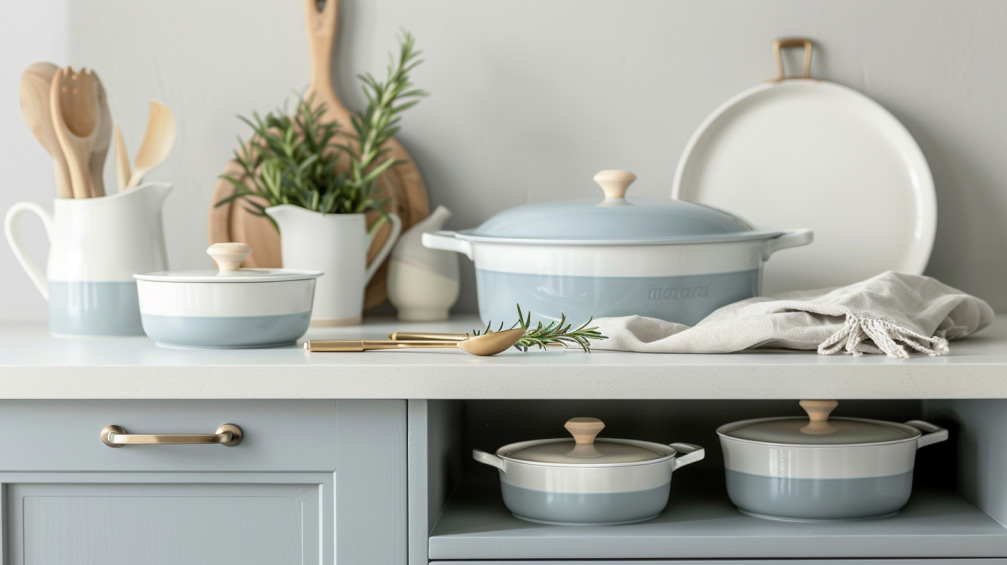
One of the most common mistakes during care for ceramic cookware is using metal utensils. This can scratch and wear down the ceramic, eventually causing the loss of non-stick—possibly flaking. You can use wood, silicone, or plastic utensils and it’ll be safe.
Another very common mistake is excessively high temperatures. Ceramic cookware was designed to perform best on low-medium temperatures. Such a temperature may be too much to handle for the ceramic, which can result in cracking or damage to the coating. Be sure to let your cookware heat up gradually and use an appropriate level of heat according to the food you’re cooking.
Yet another major problem is improper cleaning methods. This will scratch or degrade the ceramic surface because of abrasive sponges or harsh chemical cleaners. Hand washing in warm soapy water should generally be enough to clean ceramic cookware using a soft sponge. Soak the cookware in some warm water to remove hard stains, then gently scrub it.
How to Avoid Damaging the Ceramic Coating
Such cookware requires proper care, and some important guidelines have to be followed with regard to cooking, cleaning, and storage. Always preheat at a low temperature before raising the heat, gradually, to what you need. This helps avoid any resultant thermal shock that might just make the ceramic crack. Never put very hot cookware into cold water because the extreme temperatures can cause it to crack.
One of the biggest mistakes is using high heat, which can damage the ceramic coating and cause it to crack or discolor. Always cook on medium or low heat to protect the surface and ensure even cooking.
Another common mistake is using abrasive cleaning tools like steel wool or harsh sponges, which can scratch the ceramic surface and reduce its non-stick effectiveness. Opt for soft sponges or dishcloths to clean your cookware.
Additionally, some people overlook the importance of proper storage. Stacking ceramic cookware without protection can lead to chips or cracks. To avoid this, use pan protectors or a soft cloth between pieces to preserve the surface.
Never use steel wool or any rough material to clean your ceramic cookware because these will scratch the non-stick coating, which provides easier access for it to be further damaged. Clean with a soft sponge or cloth and gentle dish soap. In case there are more recalcitrant stains or burned-on foods, apply a paste made with baking soda and water, let that sit, and scrub it gently.
Proper storage is also one surefire way of preventing damages in ceramic coating. Stacking ceramic cookware without protection is definitely a no-no. Inserting a soft cloth, paper towel, or felt pad between cookware can help maintain the integrity against scratches and chips. If space allows, hanging cookware or using a dedicated storage rack keeps each piece separate and safe from damage.
Also, never use aerosol cooking sprays directly on the ceramic surface. Such sprays can be really difficult to clean off and quite detrimental to the non-stick properties of your cookware. Instead, grease the pan with a little oil or butter if need be.
Keeping these common mistakes in mind and maintaining your ceramic cookware in the right way will increase its lifespan. Always use proper utensils, cook at correct temperatures, clean with care, and store the cookware properly. Such practices will help in preserving the non-stick surface and integrity of your ceramic cookware so it may serve as a useful tool in your kitchen for years to come.
Troubleshooting and Repair
Even with proper care, chipping or even cracking can still create problems that may irreparably damage Ceramic cookware. Troubleshooting and repairing your ceramic cookware can be quite instrumental in keeping it functional at its best for very long. This article gives tips on how to deal with chipped or cracked ceramic cookware, along with advice on when to repair or replace.
How to Deal with Chipped or Cracked Ceramic Cookware
Chipped or cracked ceramic cookware may be a concern, mostly if it affects the cooking surface. If it’s just a slight chipping that doesn’t expose the metal below or worsen the structural integrity of the cookware, then you will be fine and can continue to use your cookware. Avoid using metal utensils that may further worsen the chip, and you should clean your cookware extra carefully to not chip it more.
For larger chips or cracks that reveal the metal base beneath or weaken the construction of the cookware, damage should be carefully assessed. If your ceramic cookware is seriously damaged, food may stick to it and heat unevenly; this might even be dangerous due to the exposure of materials involved.
Now, if you have just a small crack, one temporary fix is to fill that with some food-safe, high-temperature epoxy. Just be sure you follow the manufacturer’s instructions and allow for full curing of the epoxy before using the cookware again. Of course, this is not a permanent fix, but it could give you a little more time.
When to Repair and When to Replace
The decision to either repair or replace ceramic cookware will depend on the extent of the damage and how vital the cookware is in your kitchen. Protective utensils and gentle cleaning techniques will still be able to keep the cookware going if the chipping is minor and surface scratches are superficial.
However, if it has developed deep cracks, chipped extensively, or its non-stick surface is peeling, then it is normally best to replace it. These kinds of damage can affect the cookware’s performance and safety, and repairs may not give back its former glory. Moreover, cookware that has a compromised non-stick surface will most likely result in food sticking and uneven cooking, which defiles the whole cooking experience.
We also recommend to see: A Quick Review of the CAROTE Pots and Pans Set, a must-have in 2024
Replacing cookware that’s badly damaged helps to ensure the cookware you are using is safe and will work. When buying new ceramic cookware, look for a high-end brand and one with a warranty. Many companies offer warranties for defects and some kinds of damage—peace of mind and added value.
On other occasions, if it has sentimental value or is part of an expensive set, then there are professional repair services. Some companies specialize in the repair of ceramic cookware by using advanced techniques to renew the non-stick surface and structural integrity of a pot or pan. While a bit pricier, it may well be worth it for high-end or treasured pieces.
Diagnosing and repairing ceramic cookware gives you a clear decision on when to replace or maintain your kitchen essentials. While small chips and superficial damage may be preserved sustainably through careful usage and protection, more serious cracks and peeling generally mandate replacing the cookware for safety and efficiency in cooking. If you have invested in good, high-quality ceramic cookware and followed the instructions for care, you could use such versatile kitchen tools for years.
Conclusion
Proper care allows ceramic cookware to remain non-stick, heat-distributive, and long-lasting. These are basically the most important considerations: Always use wooden, silicone, or plastic cookware to avoid scratching the ceramic surface. Cook on low to medium heat; do not allow overheating and consequential cracking. Clean cookware with warm soapy water and a soft sponge. Never scrub off food with abrasive pads or harsh chemical cleaners. For more persistent residues, soak the cookware or clean delicately using a paste of baking soda. Proper storage also avoids damage, such as putting soft cloths or felt pads between stacked pieces.
By following these tips, you will be able to cook hassle-free and clean up easily with your well-maintained ceramic cookware. Proper care not only actually preserves the cookware functionality but also prolongs its life, thus being a valuable investment in your kitchen. Encourage yourself to integrate these practices into your daily routine so your ceramic cookware is always in top shape to serve you for a very, very long time.
FAQs
- How should I clean my ceramic cookware to ensure it lasts longer?
- It’s best to wash ceramic cookware with warm water and mild dish soap. Avoid using abrasive sponges or harsh chemicals to prevent damage to the surface.
- Can I use metal utensils with my ceramic cookware?
- It’s recommended to avoid metal utensils, as they can scratch and damage the ceramic coating. Instead, opt for wooden, silicone, or plastic utensils.
- Is it safe to use ceramic cookware on high heat?
- Ceramic cookware performs best on medium heat. High heat can cause the ceramic surface to crack or discolor. Always use moderate temperatures to preserve the coating.
- How do I prevent my ceramic cookware from staining?
- To avoid stains, clean your cookware promptly after each use, especially after cooking with oily or acidic foods. Regular cleaning will help maintain its appearance.
- Can I use ceramic cookware in the oven?
- Yes, most ceramic cookware is oven-safe. However, always check the manufacturer’s instructions for specific temperature limits and any restrictions for your cookware.
- What should I do if my ceramic cookware becomes scratched?
- If scratches occur, avoid using the cookware for high-heat cooking. While small scratches might not affect its functionality, large ones can compromise the non-stick surface.
- How can I restore the non-stick surface of my ceramic cookware?
- To maintain the non-stick surface, regularly season your ceramic cookware with a small amount of vegetable oil. Heat the pan on low heat to allow the oil to coat the surface.
- Can I wash my ceramic cookware in the dishwasher?
- It’s best to hand wash ceramic cookware to avoid exposure to harsh detergents and high temperatures in the dishwasher, which can damage the coating.
- How do I store my ceramic cookware properly to prevent damage?
- To prevent chipping or scratching, store your ceramic cookware with a cloth or pan protector between pieces if stacking. Alternatively, hang them up to avoid contact with hard surfaces.
- How long should my ceramic cookware last if cared for properly?
- With proper care, ceramic cookware can last for several years, depending on the quality of the ceramic coating and how often it’s used. Regular maintenance and gentle cleaning are key to extending its lifespan.

